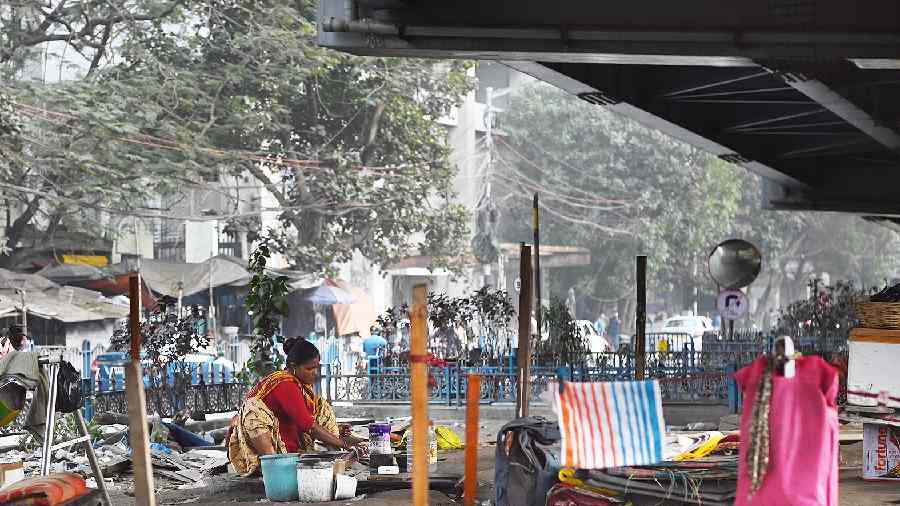Scores of people have built their homes under the Park Street flyover, on the pavements near Moulali crossing and outside the gate of Nonapukur tram depot.
The pavements at Moulali and Nonapukur are blocked by the settlements.
Discarded flexes, pieces of wood, used items like glass and plastic bottles are stacked on the footpath. Bus shelters next to the settlements are no longer used by passengers.
The barren land under the Park Street flyover has several families living there.
Kolkata’s mayor Firhad Hakim told The Telegraph on January 24 that he has written to the city’s police commissioner so that police identified those living on pavements and shifted them to the shelters for the homeless. “The letter has been sent to the police commissioner,” Hakim had said.
“We have received many complaints of people living on pavements getting involved in drug peddling. There have been specific complaints about some people living on the pavement around Park Street,” he said.
At Moulali, a woman was cooking on the footpath when The Telegraph visited the place on January 24. She said there were about 15 people living on the 100-meter stretch of the northern pavement near the Moulali crossing.
“There are 50 others on the lane going inside but those who couldn’t set up their makeshift homes on the lane are still living on the footpath,” she said. “Most of us here do not have any place to live,” said the man.
The police come often and do a survey of the place, noting down the names of people and then leave. “We were promised homes earlier also but nothing moved,” she said.
A young man who arrived while the conversation was going on said he used to drive cars to make a living. “I have my home in Joynagar but there is no scope for income there. So I am living here. I have a three-wheel cart that I use to supply vegetables to various markets,” said the man.
Two bus shelters on the same pavement are now lying unused.
Belongings of the street dwellers lie strewn around the bus shelters. Pedestrians prefer to stand on the road away from the bus stop and the police, too, make no effort to make buses stop at the designated bus stop.
“Earlier there were raids to clear the footpath and make space for pedestrians but that has stopped now,” said a police officer.
The iron fencing separating the road from the pavement was used to dry clothes. A few men and women were also seated on three-wheelcarts parked along the road and on the pavement.
A kilometre away, near the gate of the Nonapukur tram depot, about 150-metre stretch of the footpath was lined with dwellings. On this stretch too, there was no scope for walking.
Under the Park Street flyover, about 15 people lived on the southern side of the Park Street crossing.
On the northern side of the crossing there were about 40 more people living under the flyover, conversations with the dwellers revealed.
Glass and plastic bottles were stacked in one corner, and some of the tree branches were used to hang plastic bags containing various belongings of the dwellers. The dusty and dirty underbelly of the flyover gave them shade from heat and rain, said a dweller.
“We have been living here even before the flyover was built. I have three daughters and a son. All my daughters go to school. My son has still not reached the age to go to school,” said the woman, who looks after her kids while her husband worked as a cook in a roadside eatery.
